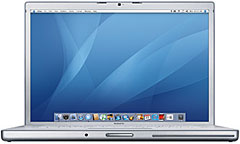Apple introduced its 15" notebook form factor with the original titanium PowerBook
G4 in January 2001. The 1" thin laptop had an 1152 x 768 display,
which was upgraded to 1280 x 854 display in the April 2002 version. Apple
redesigned the 15" PowerBook
in aluminum, introducing the new model in Sept. 2003, and the final
revision, released in Oct. 2005, increased screen resolution to 1440 x
900.
Core Duo
 The 15" MacBook Pro (MBP) carried on
the designof the aluminum PowerBook, but with a slightly larger display
(15.4" vs. 15.2"); it was one of the first Intel-based Macs, announced
on January 10, 2006 along with the first Intel Mac mini and
the first Intel
iMac.
The 15" MacBook Pro (MBP) carried on
the designof the aluminum PowerBook, but with a slightly larger display
(15.4" vs. 15.2"); it was one of the first Intel-based Macs, announced
on January 10, 2006 along with the first Intel Mac mini and
the first Intel
iMac.
Apple began shipping the MacBook Pro the week of Feb. 14, 2006 - and
with faster CPUs than originally announced 1.67 GHz and 1.83 GHz
speeds. The base MBP shiped with a 1.83 GHz CPU, and the better MBP had
a 2.0 GHz CPU. For those clamoring for even more speed, there was a
2.16 GHz build-to-order option at a $300 premium. This was the
first time Apple has offered a faster CPU as a build-to-order option in
a notebook computer. 512 MB of RAM was standard, and it supports up to
2 GB.
This was Apple's first notebook with a built-in webcam, and it also
introduced the MagSafe power connector. It also has a receiver for
Apple's wireless remote and uses an ExpressCard/34 slot instead of the
older CardBus slot for adding expansion cards. The original MacBook Pro
did not have FireWire 800 and included a 4x single-layer
SuperDrive.
The new model had teething problems, and Apple kept updating the
firmware until it got things right. The Core Duo MacBook Pro originally
shipped with Mac OS X 10.4.4, the first universal binary version of OS
X. It also included iLife '06 (also a universal binary). The MBP was
speed bumped to 2.0 GHz and 2.16 GHz in May, and a glossy display
option was added. Models with the newer logic board require OS X
10.4.6.
Throughout the history of the MBP, Apple has priced the base model
at US$1,999 and the more powerful one at US$2,499.
Core 2 Duo
The next improvement was moving to the Intel Core 2 Duo CPU, which
took place in Oct. 2006. The Core 2 Duo MacBook Pro used a
more efficient CPU, bumped speeds to 2.16 GHz and 2.33 GHz, gained
FireWire 800 and doubled base RAM to 1 GB. The Core 2 CPU allows up to
3 GB of RAM (a 1 GB module plus a 2 GB one) and supports 64-bit
operation, and a 6x dual-layer SuperDrive was included.
Santa Rosa
In June 2007, the "Santa
Rosa" MacBook Pro was introduced using Intel's new Santa Rosa
chipset. This included support for an 800 MHz system bus, up from 667
MHz in earlier models. CPU speeds were 2.2 GHz and 2.4 GHz. Nvidia
GeForce 8600M GT graphics replace the ATI Mobility Radeon X1600 of
previous versions, and the SuperDrive was upgraded to 8x.
Perhaps the biggest new was the use of LED backlighting on the
display, which was lighter, more energy efficient, and more
environmentally friendly that the older technology. On the down side,
the new MBP supported full USB power on only one of its two USB 2.0
ports.
When 4 GB memory modules became available, users discovered that the
Santa Rosa models support up to 6 GB of total RAM - one 2 GB module
with one 4 GB module. Those who attempted to use two 4 GB modules (8 GB
total) ran into problems.
Penryn
The Feb. 2008 revision of
the MacBook Pro moved to Intel's new Penryn CPU, another
improvement to the Core 2 design. CPU speeds were 2.4 GHz and 2.5 GHz,
with a 2.6 GHz build-to-order option. Base memory was increased to 2
GB, and video RAM was doubled.
With this model, the Apple Remote became a $20 option. This was the
last model to use the original MBP design.
Unibody
 Apple
introduced a new design in Oct. 2008. Often called the "Unibody" MacBook Pro, the new
model's enclosure was carved from a block of solid aluminum, the
SuperDrive was moved from the front to the right side, and all of the
ports were placed on the left side. The new model was thinner than ever
at 0.95" thick, and the backlit keyboard introduced in the original MacBook Air
replaced Apple's traditional notebook keyboard.
Apple
introduced a new design in Oct. 2008. Often called the "Unibody" MacBook Pro, the new
model's enclosure was carved from a block of solid aluminum, the
SuperDrive was moved from the front to the right side, and all of the
ports were placed on the left side. The new model was thinner than ever
at 0.95" thick, and the backlit keyboard introduced in the original MacBook Air
replaced Apple's traditional notebook keyboard.
Visually, the biggest difference was the display, which is
surrounded in black and covered by glass. Where glossy had once been an
option, it now became the only choice.
The Unibody MacBook Pro also adopted Apple's new "glass" trackpad,
which was large, supported multitouch gestures, and had no separate
mouse button. The new model alse uses the Mini DisplayPort for
connecting an external display and is the first to use a SATA optical
drive.
Inside, the MBP has moved to a 1066 MHz system bus, and standard CPU
speeds are 2.4 GHz and 2.53 GHz. For power users, there's also a 2.8
GHz build-to-order option.

 The
The  Apple
introduced a new design in Oct. 2008. Often called the
Apple
introduced a new design in Oct. 2008. Often called the 
